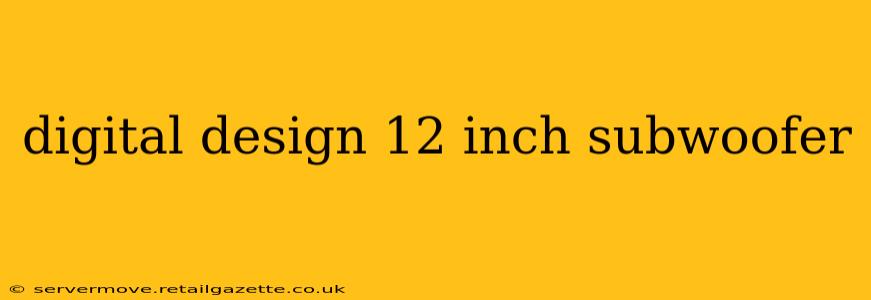Designing a high-performance 12-inch subwoofer involves a blend of art and science. It's not just about slapping together components; it's about understanding the intricate interplay between the driver, enclosure, and digital signal processing (DSP) to achieve optimal sound quality and output. This deep dive explores the key aspects of digital design for a 12-inch subwoofer, offering insights into achieving superior bass reproduction.
What are the Key Considerations in Designing a 12-Inch Subwoofer?
This is a multifaceted question, encompassing several crucial aspects. Firstly, the driver selection is paramount. We need to consider parameters like xmax (maximum excursion), sensitivity, and the driver's Thiele-Small parameters (T/S parameters). These parameters dictate the optimal enclosure type and size. Secondly, the enclosure design itself is critical. Different enclosure types – sealed, ported, bandpass, etc. – each offer unique sonic characteristics. The choice depends heavily on the desired balance between low-frequency extension, output level, and efficiency. Finally, digital signal processing (DSP) plays a crucial role in shaping the subwoofer's frequency response and overall sound. DSP allows for precise control over equalization, time alignment, and crossover points, enabling fine-tuning for optimal integration with the main speakers.
What Type of Enclosure is Best for a 12-Inch Subwoofer?
The "best" enclosure type depends entirely on your priorities. A sealed enclosure is simple to design and build, offering tight, controlled bass with low distortion. However, it generally produces less output than other designs. A ported (bass-reflex) enclosure uses a port (tube) to enhance low-frequency output and efficiency, resulting in a louder, more impactful bass response but potentially with more distortion at higher volumes. A bandpass enclosure is more complex, offering extreme output at a narrow frequency range but requiring more precise design and potentially more distortion. Choosing the right enclosure is a balance between desired sound characteristics and design complexity.
What are the Advantages of Using DSP in a Subwoofer Design?
DSP is arguably the most significant advancement in subwoofer design. Its advantages are numerous:
- Precise Equalization: DSP allows for fine-tuning of the subwoofer's frequency response, compensating for irregularities in the driver and enclosure. This ensures a flat, even bass response across the operating range.
- Time Alignment: DSP can delay the subwoofer's output to perfectly align it with the main speakers, crucial for a cohesive and accurate soundstage.
- Crossover Control: DSP manages the crossover frequency, preventing unwanted frequencies from interfering with the main speakers and ensuring a seamless blend.
- Limiter and Protection Functions: DSP incorporates limiters to prevent the driver from overexcursion, protecting it from damage and ensuring reliable performance.
- Parameter Adjustment: Many modern DSPs allow for user adjustments to fine-tune the subwoofer's sound to the specific listening environment and personal preferences.
How Do I Choose the Right 12-Inch Subwoofer Driver?
Selecting the appropriate driver requires careful consideration of several factors:
- Xmax (Maximum Excursion): This parameter indicates how far the cone can move before distortion. A higher Xmax allows for greater output at lower frequencies.
- Sensitivity: Higher sensitivity means the driver produces more output for a given amount of power.
- Thiele-Small Parameters: These parameters (Fs, Qms, Qes, Qts, Vas, etc.) are crucial for accurate enclosure design. They describe the driver's mechanical and electrical characteristics.
- Power Handling: The driver must be capable of handling the amplifier's power output without damage.
You can find these specifications in the driver's datasheet provided by the manufacturer. Using subwoofer design software that incorporates T/S parameters is essential for accurate enclosure modeling.
What Software Can I Use to Design a 12-Inch Subwoofer Enclosure?
Several software packages can assist with subwoofer enclosure design. Some popular options include WinISD, BassBox Pro, and PCD. These programs allow you to input the driver's T/S parameters and specify the desired enclosure type, enabling accurate predictions of the subwoofer's performance.
Designing a high-performance 12-inch subwoofer requires a detailed understanding of acoustics, electronics, and digital signal processing. By carefully considering each aspect – driver selection, enclosure type, and DSP implementation – you can create a system capable of delivering powerful, accurate, and controlled bass reproduction. Remember that precise measurements and testing are crucial to fine-tune the final product and achieve optimal performance.
